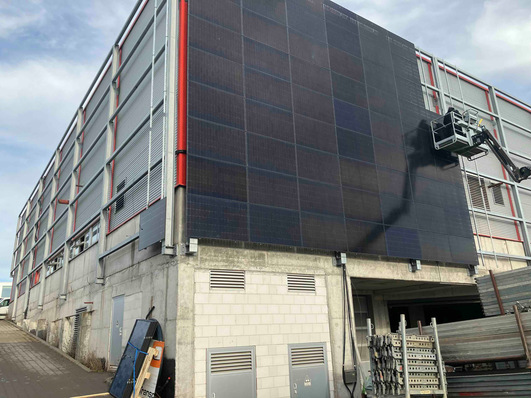It is a unique building that has been created on the Novartis Campus, the research site of the Swiss biotechnology and pharmaceutical company, in Basel. This is because the architects from AMDL Circle and Michele De Lucchi have opted for a circular structure that extends over three levels - a ground floor, a mezzanine and an upper floor. This was intended to strengthen the connection between visitors to the pavilion and Novartis employees.
Light reflects off the metal facade
On the ground floor, the building is glazed all around, which also creates a connection to the outside area. The facade areas above, however, are equipped with a metal shell. In front of this, organic solar modules and a network of LED lights have been attached to a lightweight construction. These LED elements do not shine away from the facade, but directly onto the metal shell of the upper floor. There, the light is reflected and shimmers through the semi-transparent organic solar foils to the outside. In this way, it is possible to apply different colour combinations to the membrane, so that different contents appear on the facade again and again.
Organic solar foils have advantages
The organic solar modules of the manufacturer Asca from the Franconian town of Kitzingen provide the energy for the media facade. The advantage - apart from their semi-transparency - is that they can be produced in different shapes, are flexible and, above all, very light-sensitive. This means that they also supply electricity when they are not ideally aligned to the sun. This makes them a perfect fit not only for the circular facade of the Novartis Pavilion. Even at dusk, they can still supply enough energy to power the media facade.
Energy even after sunset
A total of 10,680 of these organic solar elements supply the 15,120 LED cores with enough power to run moving type over the media facade in Basel completely self-sufficient in energy during the day. The energy is also sufficient to illuminate the facade with art animations for up to two hours after sunset. These animations were created by international artists Daniel Canogar, Esther Hunziker and Semiconductor and always run alternately. They were curated by the House of Electronic Arts (HEK) in Basel. (su)
Also worth reading:
Sunovation uses new coating technology for coloured BIPV modules
ASCA increases output of organic solar cells with new semiconductors







